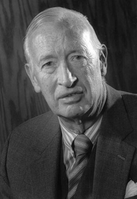










Paul Charles Zamecnik (1912–2009) was an American scientist who played a central role in the early history of molecular biology. He was a professor of medicine at Harvard Medical School and a senior scientist at Massachusetts General Hospital. Zamecnik pioneered the in vitro synthesis of proteins and helped elucidate the way cells generate proteins. With Mahlon Hoagland he co-discovered transfer RNA (tRNA).Through his later work, he is credited as the inventor of antisense therapeutics. Throughout his career, Zamecnik earned over a dozen US patents for his therapeutic techniques. Up until his death in 2009 he maintained a lab at MGH where he studied the application of synthetic oligonucleotides (antisense hybrids) for chemotherapeutic treatment of drug resistant and XDR tuberculosis in his later years.
Early Life and his Research Career
Paul C. Zamecnik was born in Cleveland. He attended Dartmouth College, where he majored in chemistry and zoology and graduated with a bachelor's degree in 1933. He then went Harvard Medical School, received his M.D. in 1936, and served his residency at Harvard from 1936 to 1938 and interned at the University Hospitals in Cleveland until 1939.
Although Zamecnik trained to be a medical doctor, science had always appealed to him. He approached Max Bergmann (who was co-author of a previous Journal of Biological Chemistry (JBC) Classic) in 1939, hoping to work with him on protein synthesis at the Rockefeller Institute. Bergmann, however, turned him down because Zamecnik had an M.D. and not a Ph.D. Zamecnik did however get a fellowship to work with Kaj Linderstrom-Lang at the Carlsberg Laboratory in Denmark. Linderstrom-Lang was a leader in protein chemistry, and Zamecnik obtained enough training and experience that Bergmann offered him a job when he returned to the States in 1940.
Zamecnik didn't stay at the Rockefeller for long. A year later he was offered a job at the Huntington Memorial Hospital of Harvard University at the Massachusetts General Hospital. There he worked with Fritz Lipmann, author of a previous JBC Classic, using radioactive isotopes to prove that proteins were built from amino acids in a process requiring ATP. In 1942 Zamecnik became an Associate Professor of Medicine at Harvard Medical School.
Zamecnik's interest soon turned to how protein sequences were specified, and he started to isolate and identify the components necessary for protein synthesis. By 1953 he had succeeded in making the first cell-free system capable of carrying out net peptide bond formation using 14C-amino acids. Using this system, he, Elizabeth Keller, and Mahlon Hoagland demonstrated the initial step in protein synthesis: the activation of amino acids by formation of aminoacyl adenylates from amino acids and ATP .
A few years later, Zamecnik and Hoagland discovered a molecule that is essential for protein synthesis: tRNA. This discovery is the subject of the JBC Classic reprinted here. Using the cell-free system, Zamecnik and Hoagland noticed that the RNA in a particular cytoplasmic fraction became labeled with 14C-amino acids and that the labeled RNA was subsequently able to transfer the amino acids to microsomal protein. The transfer was dependent upon guanosine triphosphate. From this they concluded that the RNA, later named transfer RNA or tRNA, functions as an intermediate carrier of amino acids in protein synthesis. Zamecnik and Hoagland later contributed to our understanding of how the transfer process works.
In 1978, Zamecnik's research took on a new direction. He demonstrated that short chains of antisense DNA, chemically synthesized to be complementary to selected RNA targets in the cell, could be used to selectively inactivate the expression of specific genes. This led to a new area of research and opened up the possibilities of antisense RNA therapeutics that could halt protein synthesis in viral or cancer cells. Based on this antisense therapeutic technology, Zamecnik co-founded the company Hybridon, Inc. in 1990. He continues to conduct and supervise research at Hybridon and at Massachusetts General Hospital and is a Professor Emeritus at Harvard University.
Zamecnik has earned over a dozen U. S. patents for his therapeutic techniques. He has also won many awards for his work, including the American Cancer Society National Award (1968), the National Medal of Science (1991), the Lasker Award for Special Achievement (1996), and the American Society for Biochemistry and Molecular Biology Merck Award (1997). He served as President of the American Association for Cancer Research (1964 to 1965) and was elected to the National Academy of Sciences in 1968.
Hoagland remained at Harvard University Medical School until 1967 when he was appointed professor at Dartmouth Medical School and scientific director of the Worcester Foundation for Experimental Biology in Shrewsbury, MA. In addition to his work on tRNA, Hoagland is known for his investigations on the carcinogenic effects of beryllium and the biosynthesis of coenzyme A. He was elected to the National Academy of Sciences in 1984 and currently writes about science for the public.
Albert Lasker Special Achievement Award, National Medal of Science for Biological Sciences